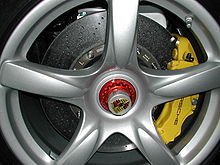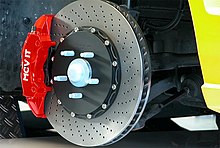Brake disc
The brake disc is the part of a disc brake on the wheel side , on which the brake linings attached to the brake caliper act to retard the rotational movement . It is almost always point-symmetrical to the center of the axle , mostly circular (see section Design variants) and consists of the actual braking surface and the offset axle attachment.
wear
The braking surface, which describes a circular ring on the brake disc, is subject to wear . The hardness of the brake discs and brake pads is coordinated so that the brake pads wear slightly higher.
materials

Brake discs are primarily of gray cast iron and partly also from nodular cast iron or made of suitable steel - alloys cast, and by turning machined.
For very high braking performance and insensitivity to fading at low weight, silicon carbide reinforced with carbon fibers and carbon fiber reinforced ceramics are also used in racing and aircraft construction.
Simple brake disks, like those on standard bicycles, are punched from sheet metal .
Disc brakes for motorcycles were not introduced until 1969 ( Honda CB 750 Four ), initially with cast iron brake discs . In order to avoid surface rust , which is inevitable with gray cast iron due to moisture and longer downtimes , the manufacturers later used low- corrosion (stainless) steels as the material for the panes.
Balancing
In order to reduce additional loads on the chassis at higher wheel speeds due to unevenly distributed masses, brake discs are balanced after machining . Cast brake discs in particular initially have higher imbalances due to the manufacturing process.
Design variants
In two-wheelers, the outer contour of the discs has recently been made in a wave shape instead of circular for design reasons. Marketing terms for this are wave or petal design .
burden
Vehicle braking systems must be dimensioned in such a way that the kinetic energy ( kinetic energy ) can be dissipated in the short time given by the use. The deceleration of brakes is generally significantly higher than the acceleration that the engine of the vehicle in question enables.
Brake discs are exposed to high mechanical and thermal loads because the brake system has to convert all of the kinetic energy stored in the moving vehicle into heat. This heat heats the entire brake system, but primarily the brake discs, which also have a significantly higher thermal conductivity than the brake pads due to the material used . The rate of increase in temperature is determined by the thermal capacity of the brake disc, the power supplied and the heat dissipated.
The temperature increase in turn causes a possible release of thermal energy through radiation according to the Stefan-Boltzmann law as well as through thermal convection with air movement through the airstream ( heat transfer coefficient ).
Brake systems for super sports cars have already been dimensioned with peak outputs of over one megawatt of braking power, for which active brake cooling is required.
Overheated brake discs
Overheated brake discs reduce the performance of the brake for three main reasons:
- The coefficient of friction of iron alloys decreases at high temperatures (in the area of embers from 500 ° C).
- The brake fluid in the brake caliper , more precisely the water that has accumulated in it over time due to its hygroscopic property, is heated above the boiling point; the resulting vapor bubbles push part of the hydraulic fluid back into the reservoir, especially if the brake is briefly released; however, the vapor bubbles themselves are compressible and can therefore hardly transmit brake pressure: the brake suddenly fails (“stepping into space”). The strong heating of the brake fluid occurs with prolonged exposure, for example when driving down passes. To remove the absorbed water, the brake fluid must be changed regularly.
- The structural structure of the pane, which may not be entirely uniform from the casting , leads to thermal stresses and thus potentially to permanent warpage of the pane. Lateral impact is noticeable through vibration in the brake pedal or lever and leads to significantly delayed response and reduced braking performance. The phenomenon is dangerous because it sometimes only occurs above a certain speed and then cannot be detected on a brake test bench . Another consequence can be stress cracks , which then worsen the heat dissipation and can lead to a break with devastating consequences (wheel carrier tearing off).
Wear limit
The service life of a brake disc is limited by the wear limit specified by the manufacturer , which is the minimum thickness of the disc worn down by the linings over time. This must be replaced when the wear limit is reached. If the wear limit has not yet been reached and the brake pads have to be replaced, the brake disc, minus its minimum size, must be at least as thick as it has already worn. If the brake disc is less than its minimum thickness, there is a risk that it will tear or break under load.
Braking power
To calculate the braking power to be applied by a braking system, consider as an example: A motor vehicle with a mass m of 1,500 kg at v = 200 km / h must be braked to a standstill ( v = 0 ) within t = 10 seconds , with an average deceleration of 5.56 m / s² or 0.57 g . The braking system converts the entire kinetic energy into heat , neglecting the driving resistances :
The total amount of heat (which is equal to the kinetic energy) is 2,315 k J and heats the brake discs. At the beginning, at 200 km / h, an instantaneous power of 463 kW is achieved with the assumed 0.57 g , which decreases linearly to zero with constant deceleration until standstill. However, the grip of the tires is sufficient for 1 g and more, so that over 812 kW or 1100 PS can work. The driving resistances at 200 km / h are approx. 80 to 90 kW, which results in approx. 0.1 g additional deceleration at 200 km / h.
An example calculation to estimate the temperature increase:
- Average braking power: Q / t = 2315 kJ / 10 s = 231 kW
- Only the brake discs experience the entire warming.
- Driving resistances and engine brakes are not taken into account.
- Assumed distribution of the total braking power, utilizing the axle load shift, 70% to the front brakes, the rest to the rear brakes: 2,315 kJ · 0.7 = 1,620.5 kJ front, 694.5 kJ rear.
- Distribution of the front braking power to two brake discs: Q = 1,620.5 kJ / 2 = 810.25 kJ
- Assumed mass m per brake disc: ≈ 10 kg
- Specific heat capacity c for gray cast iron: 0.46 kJ / (kgK)
With there is a heating of each front brake disc by
compared to the starting temperature. With repeated braking, for example downhill or on a racetrack, the windows can be heated to red or white heat , which can be clearly seen at night in 24-hour races such as Le Mans.
Optimizations
Internal ventilation
For better heat dissipation, internally ventilated brake disks are provided with radial cooling openings that are located between the two friction surfaces. When the impeller rotates, a centrifugal force is created , which causes a constant draft of air from the hub to the outside. This promotes heat dissipation. Despite the greater overall width and the higher weight, this design has established itself for the front axle of many motor vehicles.
Holes, grooves and slots in the friction surfaces
Furthermore, brake disks are partially axially perforated or provided with slots or grooves. Brake abrasion and water that remains on the disc when it rains should collect in the grooves and be carried away to the outside by the centrifugal force along the groove. Such measures can thus improve the response behavior in wet conditions. In contrast to grooves, holes again have no self-cleaning effect, which reduces their effect as soon as they are clogged by deposited brake dust.
Furthermore, holes in the brake disc can increase the heat dissipation.
However, the risk of stress cracks is increased by the holes; In order to avoid this, some of them are already incorporated into the mold during the mold making process .
A disadvantage, both in the case of grooves and holes, is the possible higher lining wear, because the somewhat flexible linings can be pressed into the openings at high surface pressures and removed through the sharp edge of the hole. This phenomenon can be reduced by rounding the edges of the borehole.
Heat treatment
A further improvement in braking performance can be achieved with heat-treated brake discs . Here, after turning, the pane is once again subjected to a defined heating and cooling process, which creates a uniform structure. The material now warps less. Because of the higher costs, heat-treated brake discs are only used ex works in high-performance vehicles or sports cars. In motorsport accessories, such windows are also offered for common car models at prices in the range of original parts. A separate test or entry is only necessary if sports brake pads with a higher coefficient of friction are also used.
Two-piece brake discs
Two -piece brake discs are even lighter and more powerful . The carrier pot is made of aluminum with the aim of reducing the unsprung mass and also achieving better heat dissipation at the hub and wheel. The thermal conductivity is aluminum in four times higher than steel, the hot strength and wear resistance, however, lower.
Integral brake disc
The integral brake disc is primarily available for trucks. Toothings are attached to an adapter ring, which is later screwed to the wheel hub; The brake disc is cast onto the adapter ring in a further work step. A composite casting is created between the adapter ring and the brake disc, which is intended to ensure a backlash-free connection without the two parts melting together. When heated they expand radially and when cooled they shrink radially. This avoids hot spots in the panes, which lead to tension and ultimately crack formation. Integral discs always stay flat, which leads to less wear on the brake discs and brake pads.
literature
- Hans-Hermann Braess, Ulrich Seiffert: Vieweg manual automotive technology. 2nd edition, Friedrich Vieweg & Sohn Verlagsgesellschaft mbH, Braunschweig / Wiesbaden 2001, ISBN 3-528-13114-4 .
Individual evidence
- ↑ " If the wear limit has not yet been reached and the brake pads have to be replaced, the brake disc, minus its minimum size, must be at least as thick as it has already been removed. " The workshop assumes that the brake disc thickness is only checked when replacing worn brake pads. It can be assumed that the newly installed brake pads will wear away the "second half" of the wear area of the brake disc; therefore the workshop only guarantees the brakes if this "second half" is still available. Work on the brakes that the workshop can then not guarantee must be refused - this is required by the Chamber of Crafts insurance.
- ↑ according to Wikibooks: specific heat capacities
- ↑ Integral washers (accessed on December 22, 2018)
Web links
Remarks
- ↑ ; (2) ; so: power = 463 kW














